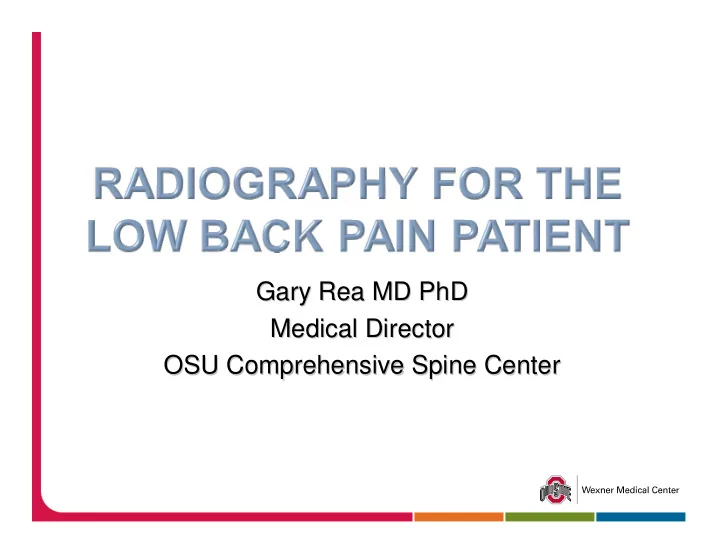

Gary Rea MD PhD Gary Rea MD PhD Medical Director Medical Director OSU Comprehensive Spine Center OSU Comprehensive Spine Center
1. What should I order? What should I order? 1. 2. When should I order it? When should I order it? 2. 3. What in the hell is the radiologist saying and is What in the hell is the radiologist saying and is 3. any of it important? any of it important?
1. Few reasons to get x- -rays rays - - no reason to get before no reason to get before 1. Few reasons to get x 4- -6 weeks, unless looking for fracture 6 weeks, unless looking for fracture 4 2. MRI - - best tool best tool 2. MRI A. If progressive weakness, numbness, cauda A. If progressive weakness, numbness, cauda equina concerns, pain not controlled with usual equina concerns, pain not controlled with usual methods methods B. If Red Flags B. If Red Flags C. I use often to rule out anatomic problem C. I use often to rule out anatomic problem
D. Insurance companies want (sometimes) D. Insurance companies want (sometimes) (1) 4- -6 weeks of activity alteration 6 weeks of activity alteration (1) 4 (2) PT, NSAIDs,and/or oral steroids (2) PT, NSAIDs,and/or oral steroids Positive SLR, numbness, weakness, Positive SLR, numbness, weakness, or reflex changes or reflex changes 3. CT- -virtually never necessary virtually never necessary 3. CT - used to evaluate fractures, fusions used to evaluate fractures, fusions - - do not order just because it is cheaper do not order just because it is cheaper - - significant radiation significant radiation -
1. Normal aging characteristics Normal aging characteristics 1. DDD - - starts in teens, twenties, by 60s it starts in teens, twenties, by 60s it DDD is seen in 100% of x- -rays, mri scans rays, mri scans is seen in 100% of x Stenosis - - product of aging product of aging- -more than 8mm more than 8mm Stenosis is is usually assymptomatic usually assymptomatic Disc space narrowing - - no relationship to no relationship to Disc space narrowing pain pain Bulging discs- -” ”just like wrinkles on the face just like wrinkles on the face” ” Bulging discs
2. What I tend to ignore on the report- - 2. What I tend to ignore on the report hemangiomas, disc degeneration, disc hemangiomas, disc degeneration, disc collapse, disc bulging, foraminal stenosis, collapse, disc bulging, foraminal stenosis, mild stenosis, stenosis of 9mm or more mild stenosis, stenosis of 9mm or more 3. What I do not ignore on the report- - 3. What I do not ignore on the report fractures, spondylolisthesis, stenosis <8mm, fractures, spondylolisthesis, stenosis <8mm, disc herniations, disc fragments, discitis, disc herniations, disc fragments, discitis, tumor tumor
Incidence of important radiographic findings on Incidence of important radiographic findings on patients with LBP- -fracture .7%,infection .4%, fracture .7%,infection .4%, patients with LBP tumor .7%,stenosis 3%,symptomatic stenosis tumor .7%,stenosis 3%,symptomatic stenosis 3%,DDD- -90% in patients >65 90% in patients >65 3%,DDD Multiple studies Multiple studies- -poor correlation between back poor correlation between back pain and MRI findings pain and MRI findings 32% assymptomatic patients have abnormal MRI 32% assymptomatic patients have abnormal MRI 47% LBP patients have normal MRI 47% LBP patients have normal MRI
45 year old female with 45 year old female with long history of low back long history of low back pain. pain. Long history of Long history of oxycontin use 240mg oxycontin use 240mg per day per day Significant tenderness, Significant tenderness, multiple positive multiple positive Waddell’ ’s signs s signs Waddell
Electrodiagnosis in Spinal Disorders Dr. Fran Pulver
Why obtain EDX testing in patients with spinal disorders? To establish and/or confirm diagnosis Radiculopathy vs. entrapment neuropathy vs. polyneuropathy Localize a lesion Nerve root vs. plexus vs. peripheral nerve To correlate findings noted on physical exam and imaging studies To determine extent, severity, and/or chronicity of a nerve injury
What are the limitations of EDX in patients with spinal disorders During the first 2-4 weeks after the onset of symptoms, EDX findings may be difficult to detect Needle EMG detects motor axon loss and does not detect sensory axon loss or demyelination Can be technically difficult in patients who are morbidly obese or with significant lower limb edema Poor patient tolerance
Other patient considerations EDX can be performed in patients on anticoagulants or have pacemaker/defibrillator If patient has a stimulator, this needs to be turned off for the test and can be turned back on after test is completed Some patients may have some mild discomfort after the testing.
Recommend
More recommend